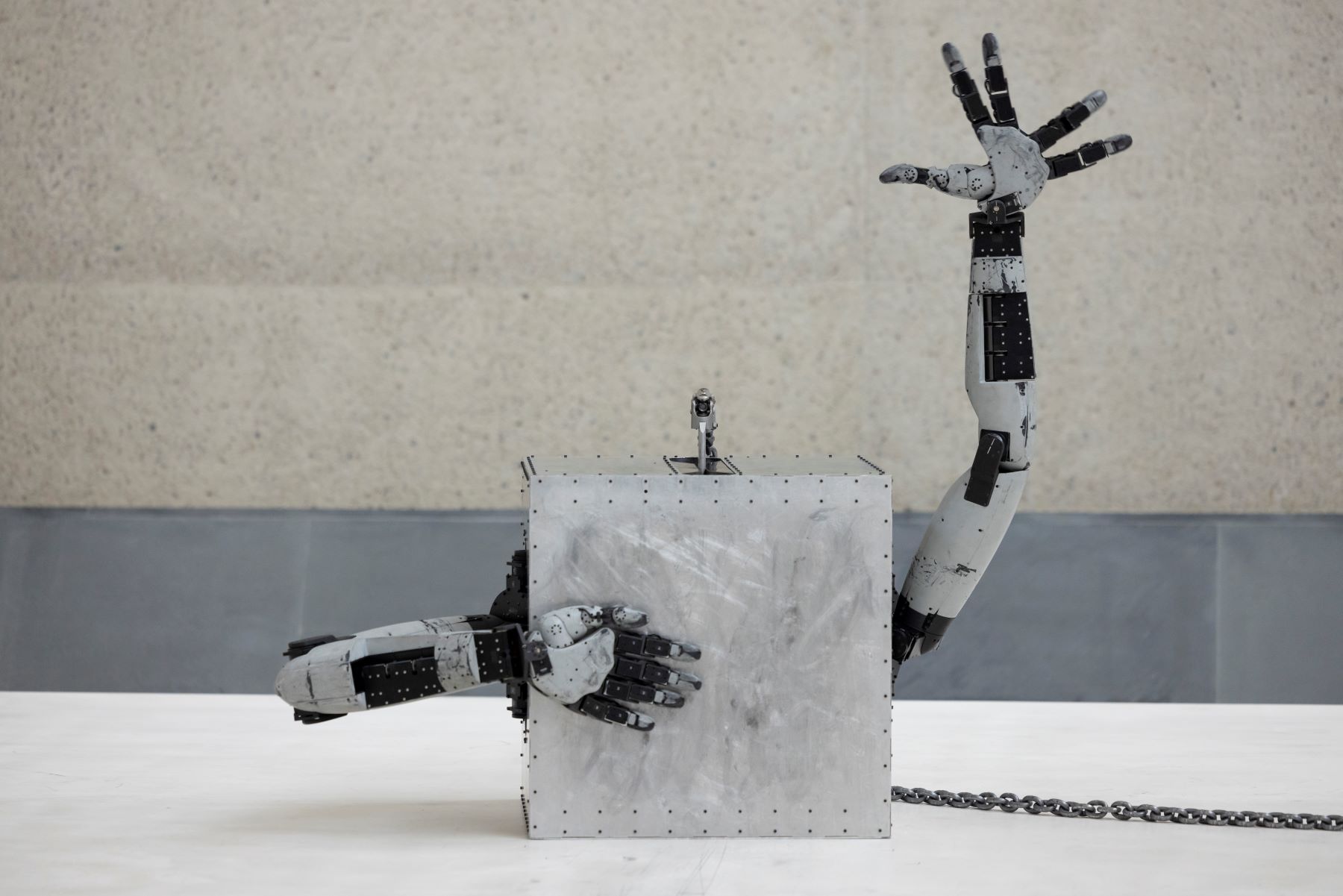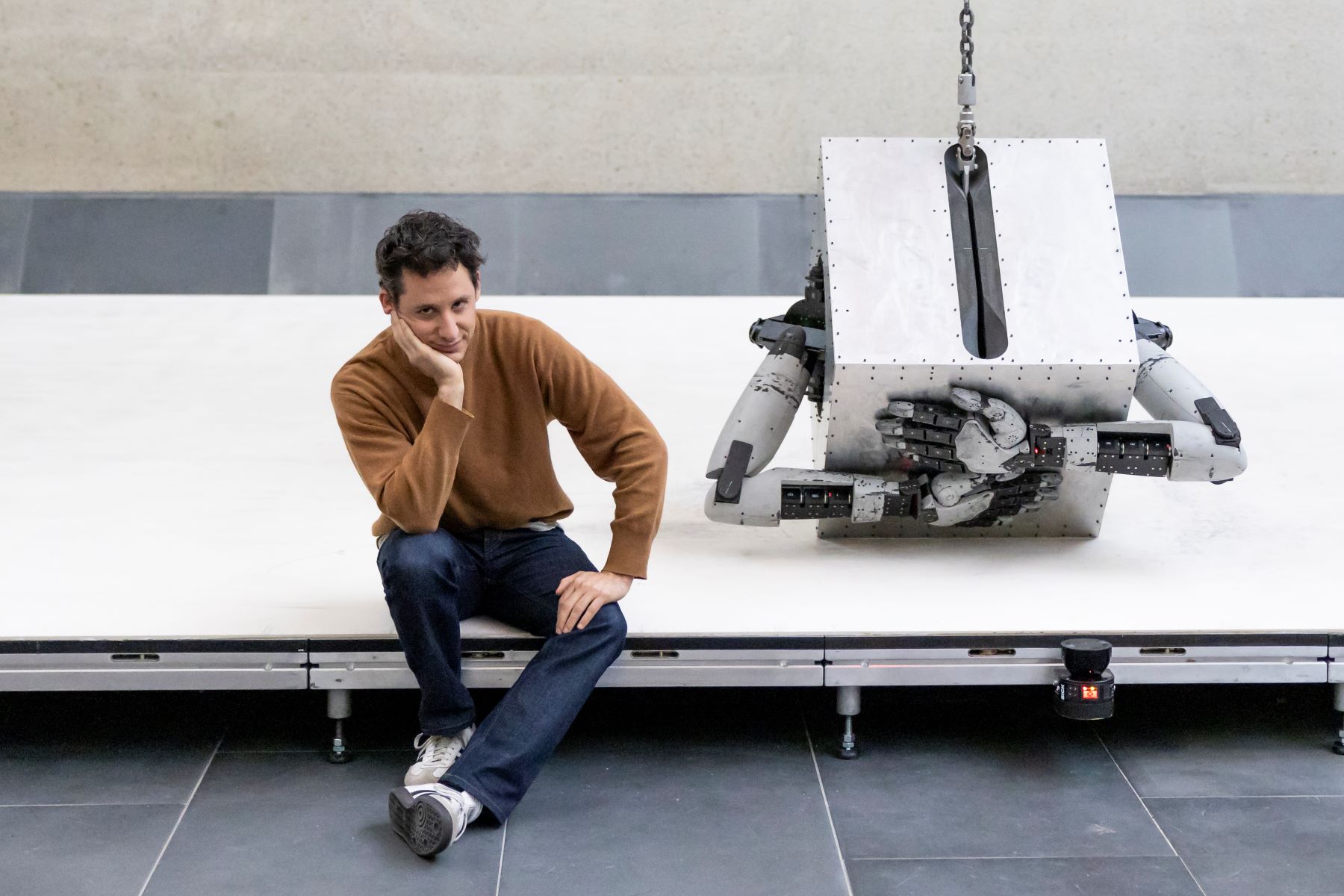A lesson in patience, emotion and the human experience awaits visitors of the unique animatronic piece Body Sculpture. The National Gallery of Australia’s new acquisition has been in the works with US-based artist Jordan Wolfson for over five years and is now available for public consumption until 28 April.
A metallic-based form, visual experience and commentary on the state of the world today, the innovative work challenges our ideas of sculpture. With a deep desire to reach his audience and evoke feelings when faced with the physical and moral confrontation of society’s issues, Wolfson draws inspiration from classic art, pop culture and mass media.
For approximately 30 minutes, the audience is invited on a journey through the ups and downs of what it means to be alive, conscious and sentient. With no gender or face, we are presented with a metal cube whose only human features are arms and hands; however, through carefully choreographed movements, we see moments of peace, despair, anger and sexuality.
Wolfson’s main collaborator, Mark Setrakian, a roboticist, composer, choreographer and percussionist, says they can’t assume that someone will react a certain way; all he can do is be honest with himself and his own feelings. However, he hopes that viewers will find something in the piece that moves them.
“The moment when the cube is looking at its hands, that’s a very personal moment for me and what you take away from that is going to be very personal for you. The emotion that stirs in me, I do not assume that anyone else will feel those same feelings but it’s rewarding.”
In Wolfson’s first solo work in Australia, Body Sculpture is shown alongside the artist’s selection of key items from the NGA’s collection that help to share insights into his vision. These include works from Mr Setrakian’s career, such as imagery from Spaceballs and Howard the Duck, the first motion pictures he worked on.
“Jordan insisted on having those clips in there because he is a fan of that era of filmmaking and it’s indicative of my very earliest work. My path to robotics starts with a passion for creating motion and living characters out of inanimate puppets,” says Mr Setrakian.

From his first job as a teenager working for George Lucas, Mr Setrakian has been actively pursuing a secondary education adding further knowledge of electronics, software, the ability to code to his repertoire.
Through years of hard work, Mr Setrakian was able to help create this piece that has palpable emotions, he says the cube is like an instrument.
“One of the turning points in my career was when I became good enough with software that I could start to write my own control systems. When that happened, in a sense I’m creating my own paintbrush, I’m stretching my own canvas, mixing my own paints and I’m creating something using bespoke elements.”
Through layers of nuance in motion, he can bring the object to life, he says he doesn’t necessarily have a plan of execution, the system invites exploration. With all this knowledge and a love of classic films, the roboticist knew how important a role a feature like hands can play, creating the cube’s with deliberate proportions.
“The hands are a little bigger than normal proportion and some of that is referencing Michelangelo’s David, where Michelangelo chose to make the hands a little bigger to emphasize human action. I was referencing Boris Karloff from Frankenstein where you have this figure and you have the sense that the hands are big and it seems like cobbled together person that has been put together by parts. That’s almost what the cube is, it is a person but it has been created, it has been made.”
The path of Mr Wolfson and the roboticist crossed after the artist was searching for someone to help with his work and was constantly told about Mr Setrakian.

“I subsequently moved to Los Angeles to work with him and it’s about ten years now and it’s been such a wonderful collaboration and friendship,” says Mr Wolfson.
As an artist, Mr Wolfson says that when you make something you don’t really know what it means, then when it is finished you still don’t really know what it means. When looking at Body Sculpture he says if you mapped it all out, it would be like poetry.
“If we had described every scene in this piece and wrote it down on a piece of paper, every stanza was a description of the scene, you would come out with this piece of poetry- good or bad but you would have some kind of poetry. I think that the work has a similar, adjacent effect to the power of formal language with poetry,” says Mr Wolfson.
Body Sculpture contains mature themes and discretion is advised, children under the age of 15 need to be with a parent or guardian. As the whole piece takes half an hour to run through, the NGA has activations at select times with it being a free, ticket exhibition.
See Jordan Wolfson: Body Sculpture at the National Gallery of Australia until 28 April; nga.gov.au
Canberra Daily is keen to hear from you about a story idea in the Canberra and surrounding region. Click here to submit a news tip.



